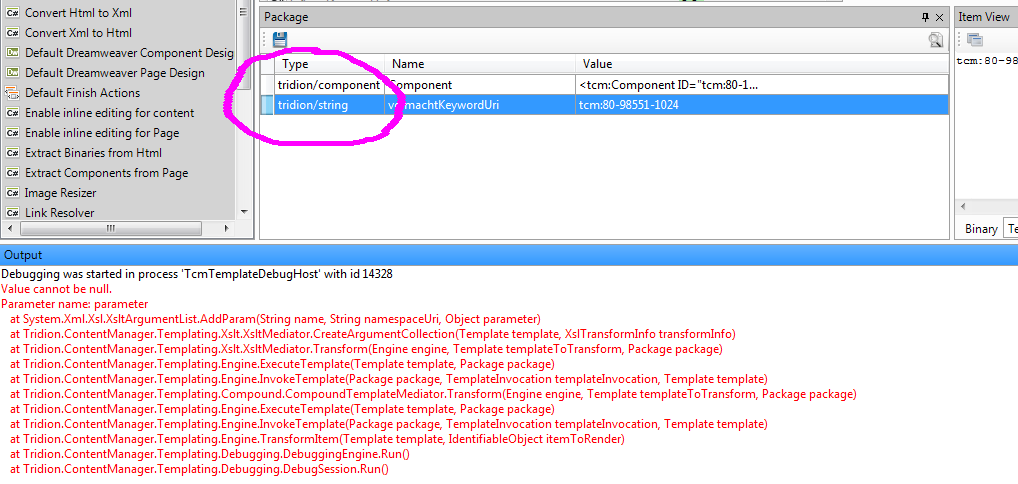Parameter type quirks of the XSLT mediator
Today I was working on a template with an XSLT building block. I'd added a parameter to the package further up, and expected to use it simply by having an <xsl:param/> element with a matching name. Instead I got the error message you can see in the screencap below... Value cannot be null, Parameter name: parameter.

So what's going on here? Well I had a bit of a dig... (obviously by using my secret powers, and nothing as humdrum as technology) and came up with a couple of interesting things. Firstly, the way I'd imagined things was all wrong. I had assumed that the mediator would loop through the package variables, and add them as parameters to the XSLT. In fact, it's the other way round. The mediator parses the XSLT to get the param elements that are declared, and loops through these to see if it can find a satisfactory parameter to add.
If you look in the documentation, you will find that there are some "magic" parameter names that will cause the mediator to pass various relevant data items as parameters. These are tcm:Publication, tcm:ResolvedItem, tcm:ResolvedTemplate and tcm:XsltTemplate. In addition to these documented parameters, tcm:Page and tcm:ComponentTemplate would also appear to work under the correct circumstances, but of course, if you want your templates to be future-proof, it's better not to use such undocumented features, especially seeing as you could just add the relevant items as XML to your package, and have the same result. It all reminds me of the old XSLT component templates, that also had magic parameters that very few people knew about.
Anyway, back to my bug - for it is indeed a bug. In addition to providing magic parameters, of course the mediator also wires up parameters that are in the package. So - having found a parameter name in the XSLT, it looks for a package item with the matching name. If the item is of type "text" or "html", then it gets added as a string. For any other item type, it tries to get an appropriate XmlDocument and add that. If this process fails, any exceptions get swallowed, and instead of an XmlDocument the "parameter" parameter of AddParam becomes null. And then we see the aforementioned "Value cannot be null. Parameter name: parameter" message, which is the .NET framework quite correctly checking its input values and refusing to play.
The solution is easy - instead of using ContentType.String when I added my parameter to the package, I used ContentType.Text, and everything worked like a charm. But not obvious, and hence the blog post. I'm sure to forget this, and having it in my "external memory" might help.
It's easy to see how this could happen. In fact, it's our old friend LOLA. The GetAsXmlDocument() method of a Templating Item returns a null if it can't manage to return the relevant XmlDocument - for all I know, this is the correct semantics for such a method. Maybe there are very good reasons for it. Still - if you're writing client code, and you don't know this, you'll fail to do the null check, and things will break. FWIW the null check is also missing in older versions of the mediator.
So - there - I've got that off my chest. I should probably report this to customer support. But it's the weekend, and seeing as my stuff works, and the answer is now google-able, I might possibly not have that much energy :-)